Two-wheeled motor vehicle with or without side trailer. "Permitted maximum weight"
Lesson 1
Introduction. Survey of legislative acts. General provisions. Basic concepts and terms.
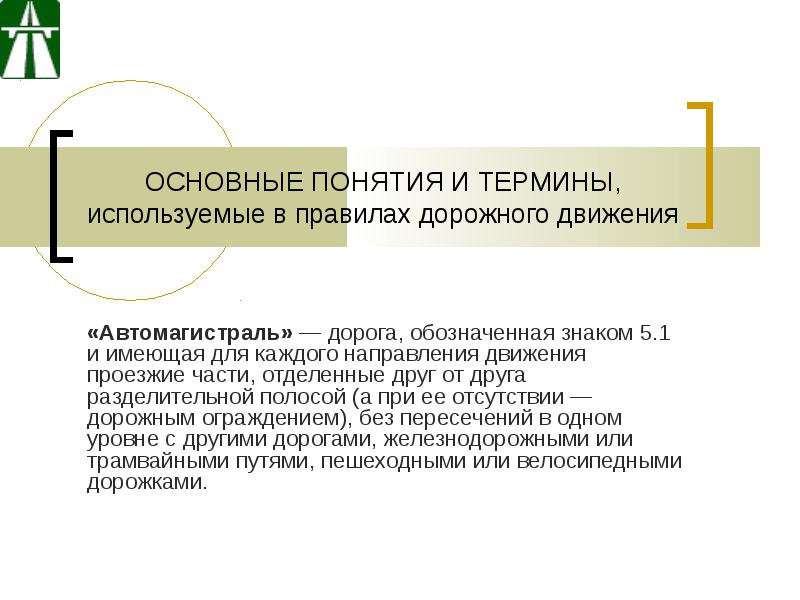

"Road train"
"Road train"- a motor vehicle coupled to a trailer (trailers).

"A bike"
"A bike"- a vehicle, other than wheelchairs, having two or more wheels and driven by the muscular power of the people on it.

"Driver"
"Driver"- a person driving a vehicle, a driver leading pack animals, riding animals or a herd along the road. A driving instructor is equivalent to a driver
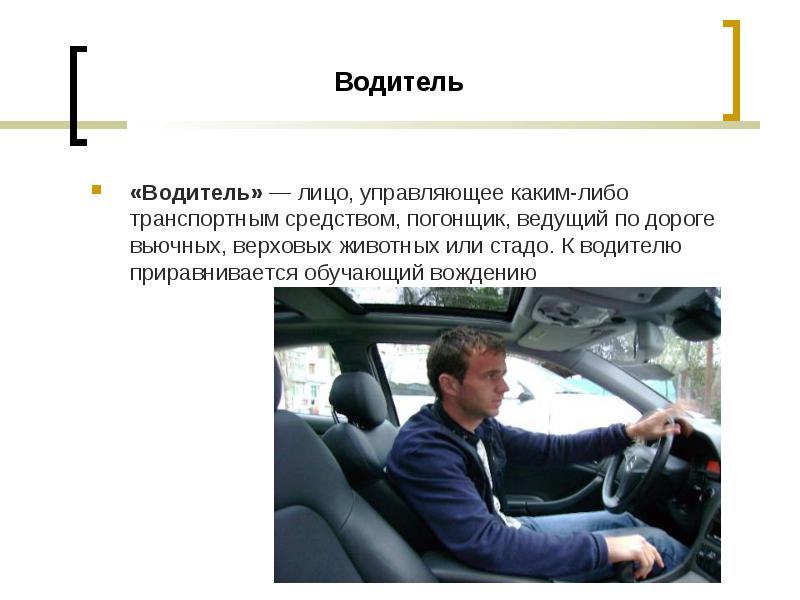
"The main road"
"The main road"- the road marked with signs 2.1, 2.3.1 - 2.3.7 or 5.1, in relation to the crossed (adjacent),
or a paved road (asphalt and cement concrete, stone materials, etc.) in relation to an unpaved one,
or any road in relation to exits from adjacent territories.
The presence of a paved section on a secondary road immediately before the intersection does not make it equal in value to the crossed one.

"Road" -
"Road" - a strip of land or the surface of an artificial structure, equipped or adapted and used for the movement of vehicles. The road includes one or more carriageways, as well as tram tracks, sidewalks, shoulders and dividing lanes, if any.

- event,
"traffic accident"- event,
arising in the process of movement on the way to vehicle and with his participation,
under which died or injured people , damaged transport facilities, structures, cargo or
caused different material damage.

"mechanical vehicle" - a vehicle, other than a moped, propelled by an engine.
The term also applies to any tractors and self-propelled machines.

"Motorbike"
"Motorbike"- a two-wheeled motor vehicle with or without a side trailer. Motorcycles are equated to three- and four-wheeled motor vehicles with a curb weight of not more than 400 kg.

"Overtaking"
"Overtaking"- ahead of one or more moving vehicles associated with the departure from the occupied lane (in the current version)
"Overtaking"- advance of one or more vehicles associated with the exit to the lane (side of the carriageway) intended for oncoming traffic, and subsequent return to the previously occupied lane (side of the carriageway)
(as amended to come into effect from November 2010)
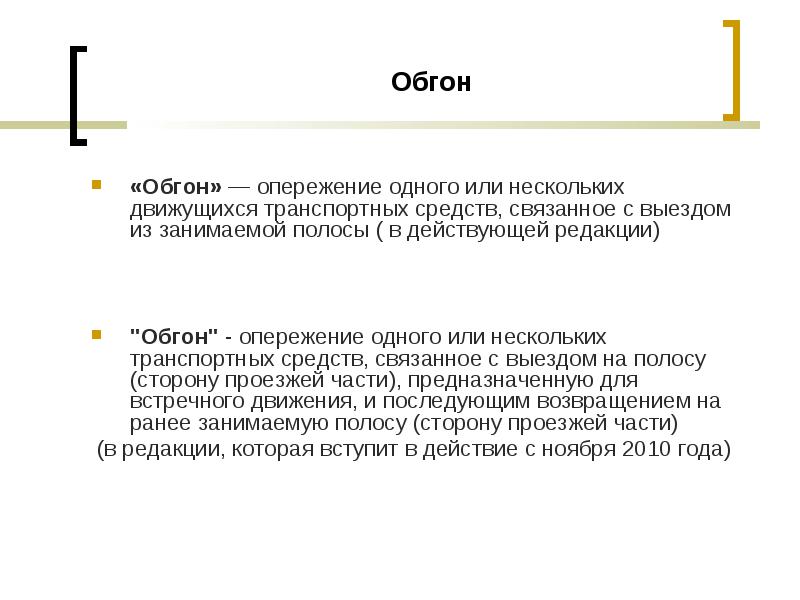
"Roadside"
"Roadside"- a road element adjacent directly to the carriageway at the same level with it, differing in the type of coverage or marked out using markings 1.2.1 or 1.2.2, used for driving, stopping and parking in accordance with the Rules.
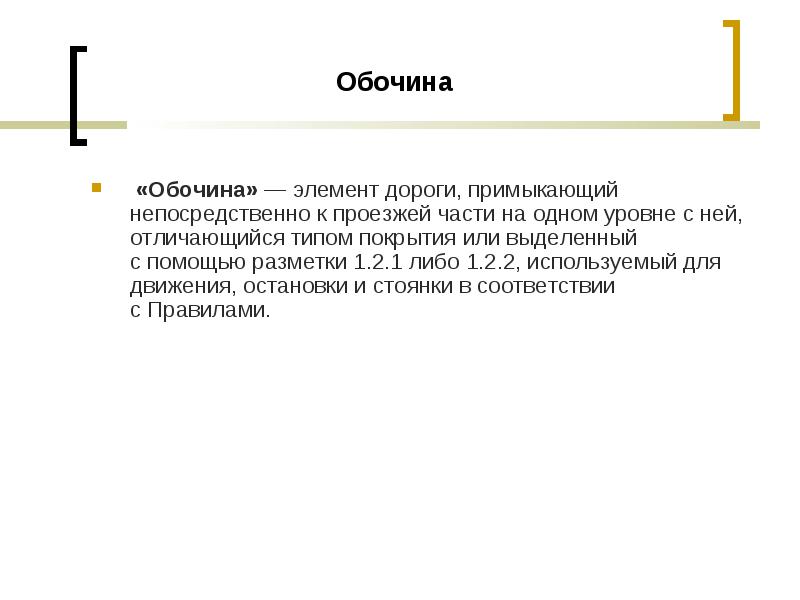
"Stop"- intentional stoppage of the movement of the vehicle for up to 5 minutes, as well as for more, if it is necessary for boarding or disembarking passengers or loading or unloading the vehicle.

"Passenger"
"Passenger"- a person, other than the driver, who is in the vehicle (on it), as well as a person who enters the vehicle (gets on it) or leaves the vehicle (gets off it).
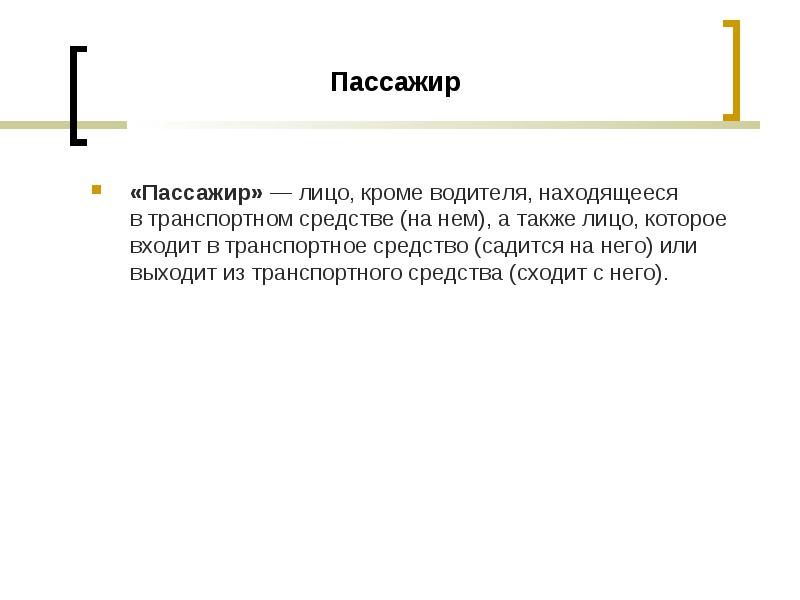
"Crossroads"
"Crossroads"- a place of intersection, junction or branching of roads at the same level, limited by imaginary lines connecting, respectively, opposite, the beginnings of the curvature of the carriageways, which are the most distant from the center of the intersection. Exits from adjacent territories are not considered intersections.
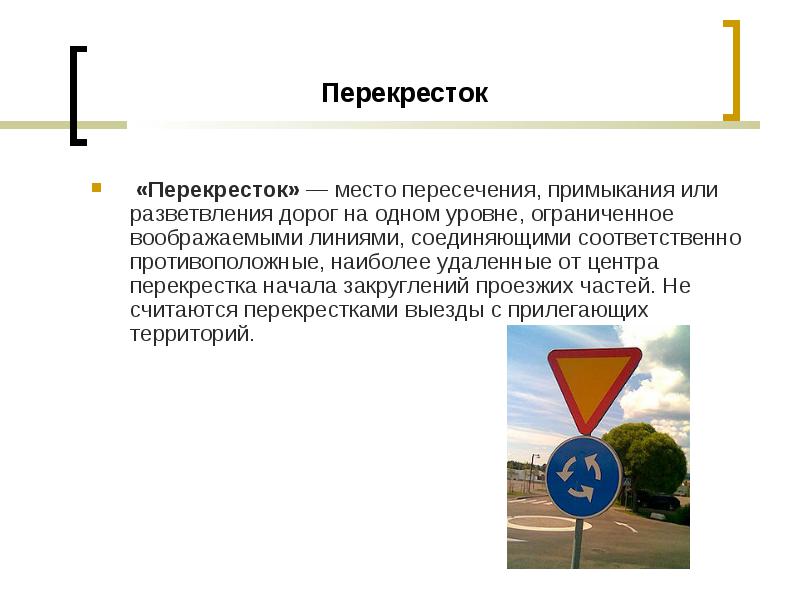
"Rebuilding"
"Rebuilding"- exit from the occupied lane or occupied lane while maintaining the original direction of movement.
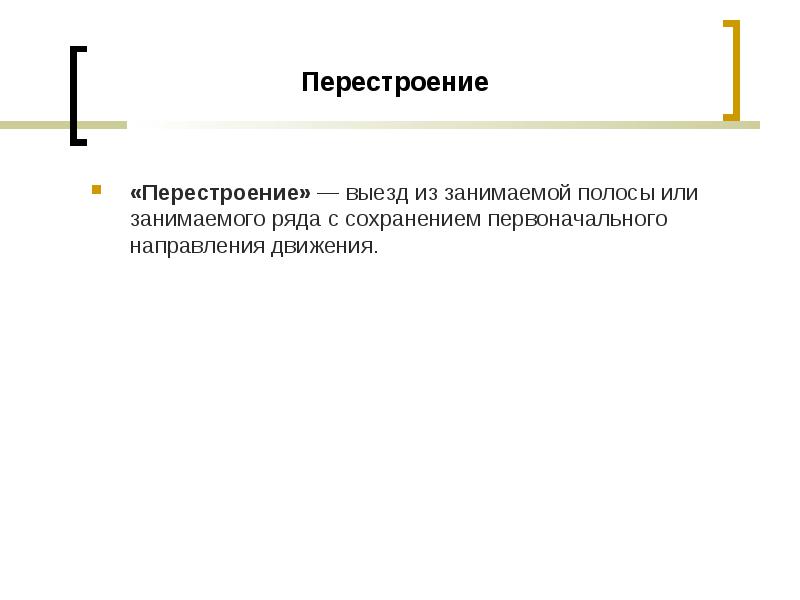
"A pedestrian"
"A pedestrian"- a person who is outside the vehicle on the road and does not work on it. Persons moving in wheelchairs without an engine, driving a bicycle, moped, motorcycle, carrying a sledge, cart, baby or wheelchair are equated to pedestrians.
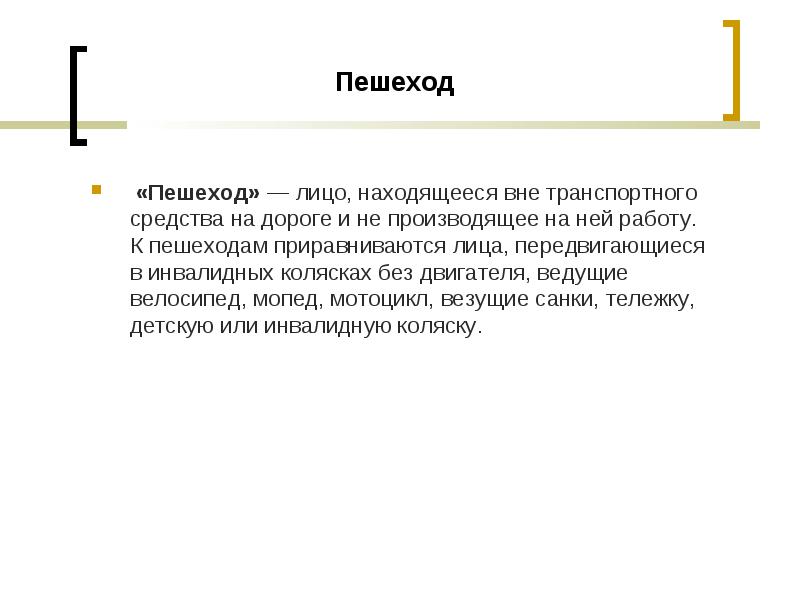
"Advantage (priority)"
"Advantage (priority)"- the right to priority movement in the intended direction in relation to other participants in the movement.

"Trailer"
"Trailer"- a vehicle not equipped with an engine and intended to be driven in combination with a power-driven vehicle. The term also applies to semi-trailers and drop trailers.

"Carriageway" of the movement of trackless vehicles.
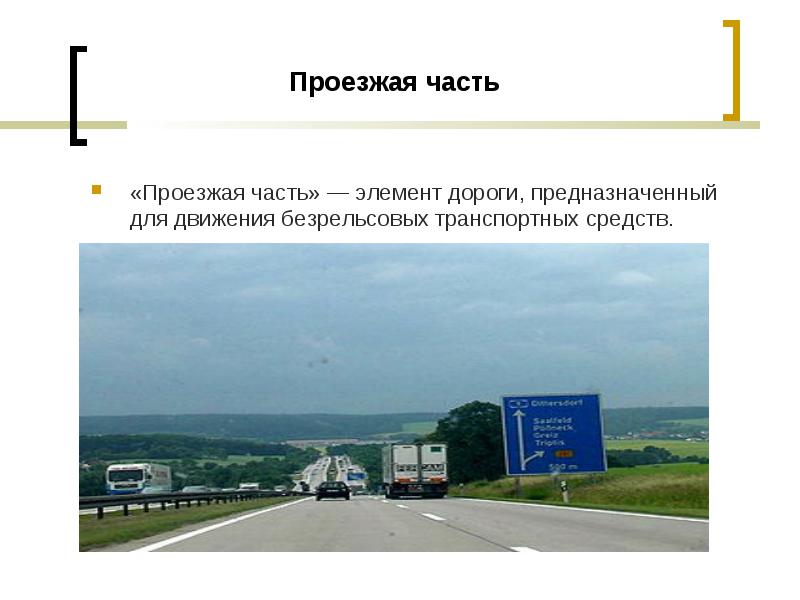
"Dividing Line"
"Dividing Line"- an element of the road, allocated constructively and (or) with the help of marking 1.2.1, separating adjacent carriageways and not intended for the movement and stopping of vehicles.
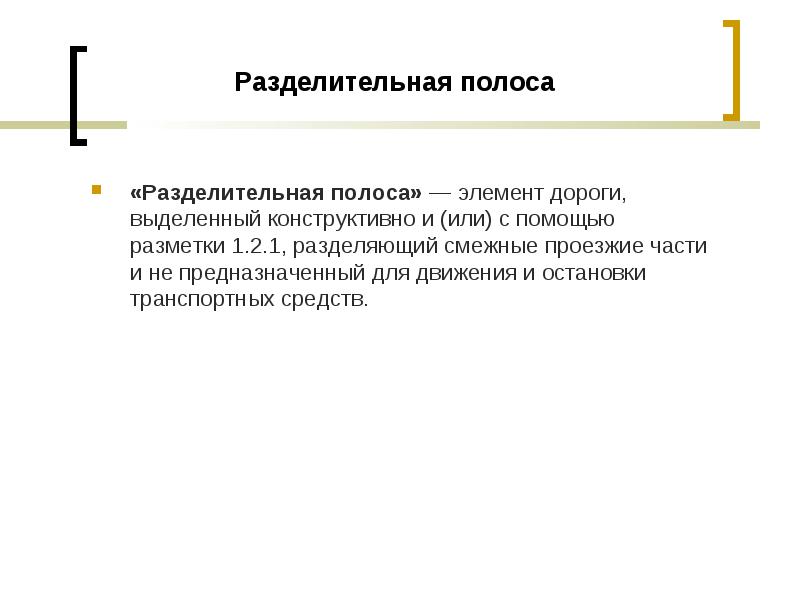
"Adjuster"
"Adjuster"- a person endowed in accordance with the established procedure with the authority to regulate traffic with signals, established by the Rules, and directly carrying out the specified regulation. The traffic controller must be in uniform and (or) have a distinctive badge and equipment. Traffic controllers include employees of the police and military automobile inspection, as well as employees of road maintenance services, on duty at railway crossings and ferry crossings in the performance of their duties.

"Parking"- intentional stoppage
vehicle for more than 5 minutes for reasons
not connected with the boarding or disembarkation of passengers, or
loading or unloading the vehicle.

"Vehicle"- device,
"Vehicle"- device,
intended for the carriage of people, goods
or the equipment installed on it.

"Sidewalk"- an element of the road intended for
"Sidewalk"- an element of the road intended for
pedestrian traffic and adjacent to the carriageway or
separated from her by a lawn.

- person receiving
"Road user"- person receiving
direct participation in the process of movement as
driver, pedestrian, vehicle passenger.
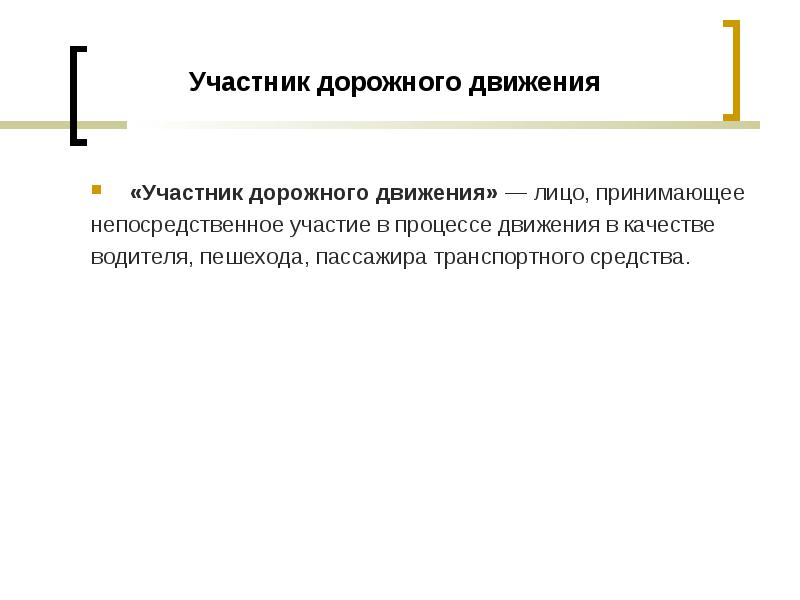
CHANGES TO SDA,
CHANGES TO SDA,
COMING INTO ACTION
From November 10, 2010

"Daytime Running Lights"- external lighting fixtures,
"Daytime Running Lights"- external lighting fixtures,
designed to improve the visibility of the moving
vehicle in front during daylight hours

"Limited visibility"- driver visibility
"Limited visibility"- driver visibility
road in the direction of travel bounded by terrain
terrain, geometric parameters of the road,
vegetation, buildings, structures or other
objects, including vehicles

"Advance"
"Advance"- movement of the vehicle
speed, greater than the speed of passing transport
facilities

"Obstacle" - an immovable object on a traffic lane (a faulty or damaged vehicle, a defect in the roadway, foreign objects, etc.), which does not allow you to continue driving along this lane.
A traffic jam or a vehicle stopped in this lane in accordance with the requirements of the Rules is not an obstacle

In the definition of "Dangerous Goods", the word "natural" has been deleted.
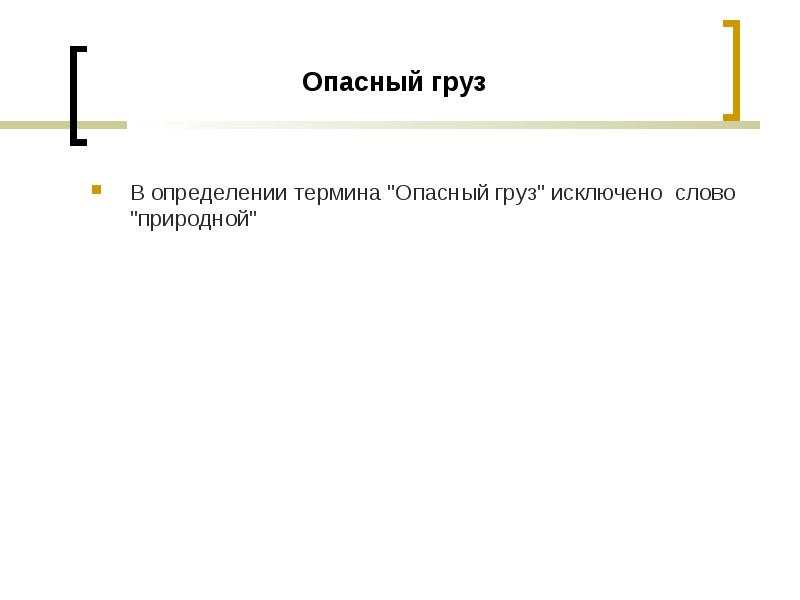
1. What are the main elements that make it possible to define an event as a traffic accident?
2. What is included in the term "road"?
3. Can an Indian rickshaw be classified as a driver?
4. What category of road users does a shepherd belong to?

1.Road marked with sign 5.1
2. Place of intersection, junction or branching of roads on the same level
3. An element of the road intended for pedestrian traffic and adjacent to the carriageway or separated from it by a lawn.
4. A person duly empowered to regulate traffic with the help of signals established by the Rules, and directly exercising the said regulation.
5. Intentional stoppage of the movement of the vehicle for up to 5 minutes, as well as for more, if it is necessary for boarding or disembarking passengers or loading or unloading the vehicle.
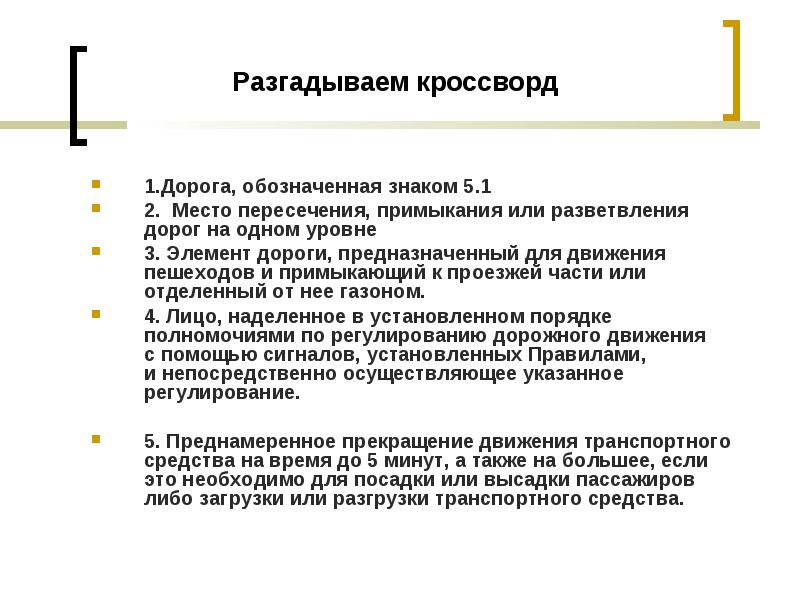
6 A person driving a vehicle or a driver leading pack animals, saddle animals or a herd along the road.
7. A vehicle not equipped with an engine and intended to be driven in combination with a power-driven vehicle.
8. Part of a road element intended for the movement of trackless vehicles
9. The person who is in the vehicle (on it), as well as the person who enters the vehicle (gets on it) or leaves the vehicle (gets off it).

10. Two-wheeled motor vehicle with or without side trailer.
11. Departure from the occupied lane or occupied lane while maintaining the original direction of movement.
12. Deliberate stoppage of the movement of the vehicle for more than 5 minutes for reasons not related to boarding or disembarking passengers or loading or unloading the vehicle.
13. Power-driven vehicle coupled to a trailer(s).

14. An element of the road adjacent directly to the carriageway at the same level with it, differing in the type of coverage or marked out using markings, used for driving, stopping and parking in accordance with the Rules.
15. Equipped or adapted and used for the movement of vehicles, a strip of land or the surface of an artificial structure.
16. Leading one or more moving vehicles associated with the departure from the occupied lane.
17. The right to priority movement in the intended direction in relation to other road users.
18. A vehicle, other than a wheelchair, having two or more wheels and propelled by the muscular power of the people on it.

UPDATE OF KNOWLEDGE

"Forced Stop"
"Forced Stop"
"Road Traffic"
"Railroad crossing",
"Route Vehicle"
"Moped",
"Locality",
"Insufficient Visibility"
"Traffic Danger"
"Dangerous Goods"
"Organized transportation of a group of children",
"Organized foot column",
"Organized transport column",
"Crosswalk" ,
"Lane"
"Neighbourhood"
"Permitted maximum weight",
"Night time",
"Give way (do not interfere)".
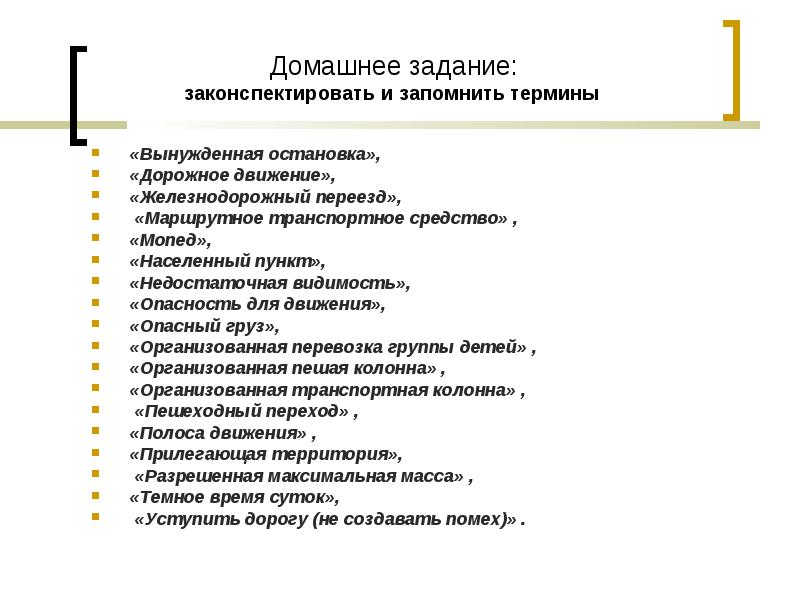
Your questions?
Your questions?
What are your criticisms?
What are your opinions?
Your suggestions?

BASIC CONCEPTS AND TERMS USED IN REGULATIONS OF THE ROAD "Motorway" a road marked with the sign 5.1 and having carriageways for each direction of movement, separated from each other by a dividing strip (and in its absence by a road barrier), without intersections at the same level with other roads , railway or tram tracks, pedestrian or bicycle paths.




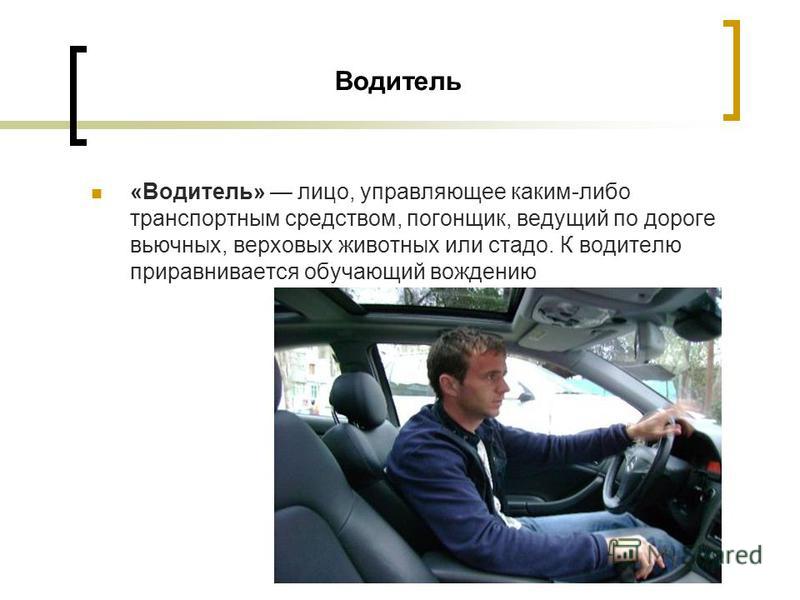
Main road "Main road" road, marked with signs 2.1, or 5.1, in relation to the crossed (adjacent), or paved road (asphalt and cement concrete, stone materials and the like) in relation to a dirt road, or any road in relation to exits from adjacent territories. The presence of a paved section on a secondary road immediately before the intersection does not make it equal in value to the crossed one.

Road "Road" is a strip of land or a surface of an artificial structure, equipped or adapted and used for the movement of vehicles. The road includes one or more carriageways, as well as tram tracks, sidewalks, shoulders and dividing lanes, if any.
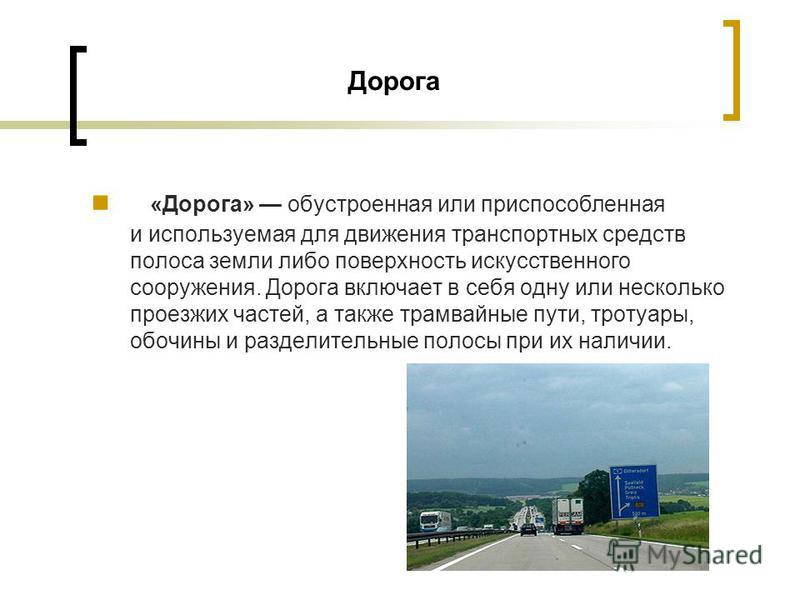
Road traffic accident "Road traffic accident" is an event that occurred during the movement of a vehicle on the road and with its participation, in which people were killed or injured, vehicles, structures, cargo were damaged, or other material damage was caused.
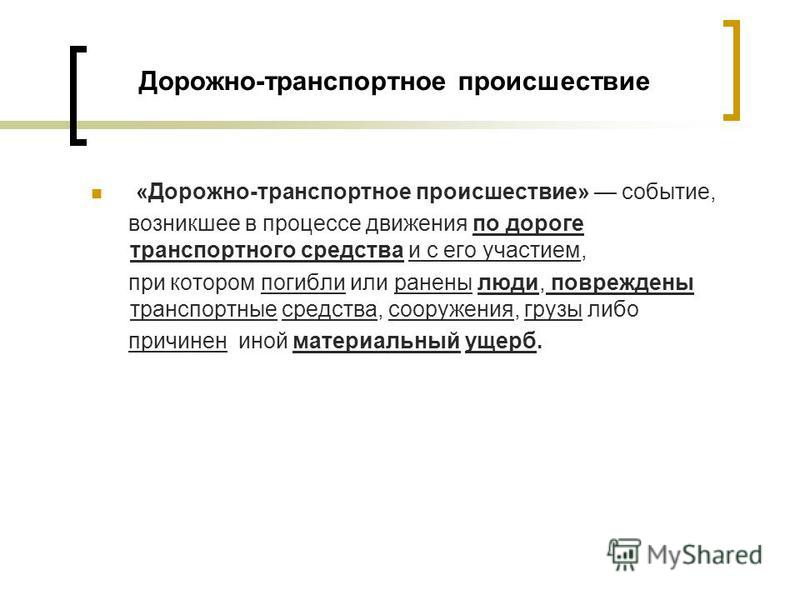
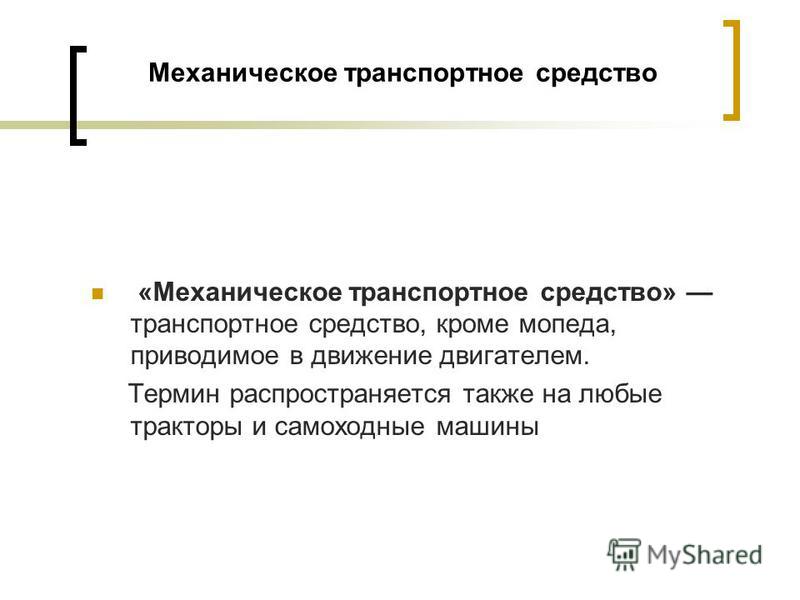
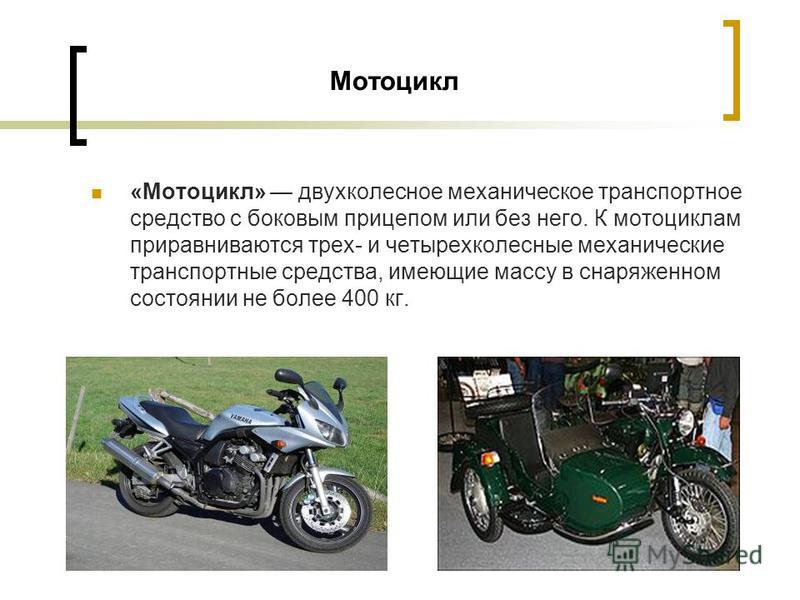
Overtaking "Overtaking" advance of one or more moving vehicles associated with the departure from the occupied lane (in the current wording) "Overtaking" - advance of one or more vehicles associated with the exit to the lane (side of the carriageway) intended for oncoming traffic, and subsequent return to the previously occupied lane (side of the carriageway) (in the wording that will come into force from November 2010)

Curb "Curb" is an element of the road adjacent directly to the carriageway at the same level with it, differing in the type of coating or marked out using markings or 1.2.2, used for driving, stopping and parking in accordance with the Rules.


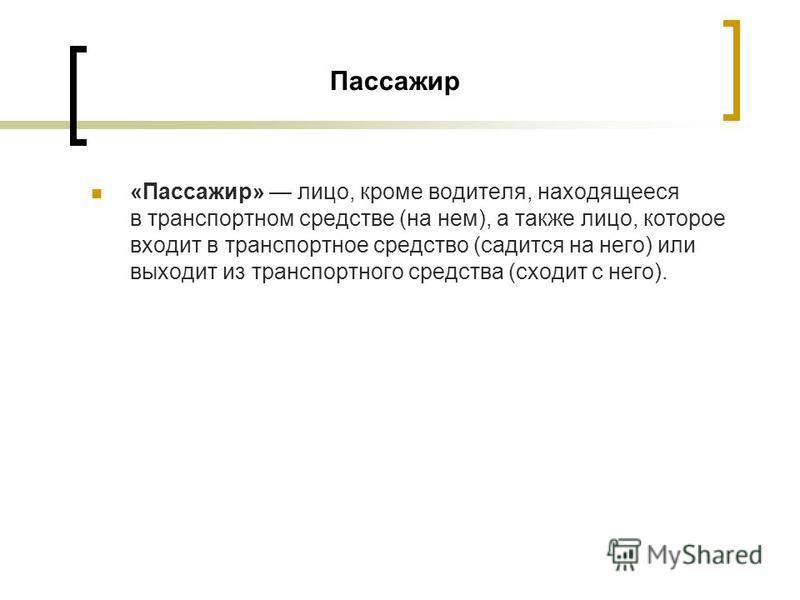
Crossroads "Crossroads" - a place of intersection, junction or branching of roads on the same level, limited by imaginary lines connecting, respectively, opposite, the beginnings of the curvature of the carriageways, which are the most distant from the center of the intersection. Exits from adjacent territories are not considered intersections.


Pedestrian A "pedestrian" is a person who is outside a vehicle on a road and does not work on it. Persons moving in wheelchairs without an engine, driving a bicycle, moped, motorcycle, carrying a sledge, cart, baby or wheelchair are equated to pedestrians.





Regulator "Regulator" is a person duly empowered to regulate traffic with the help of signals established by the Rules, and directly exercising the specified regulation. The traffic controller must be in uniform and (or) have a distinctive badge and equipment. Traffic controllers include employees of the police and military automobile inspection, as well as employees of road maintenance services, on duty at railway crossings and ferry crossings in the performance of their duties.
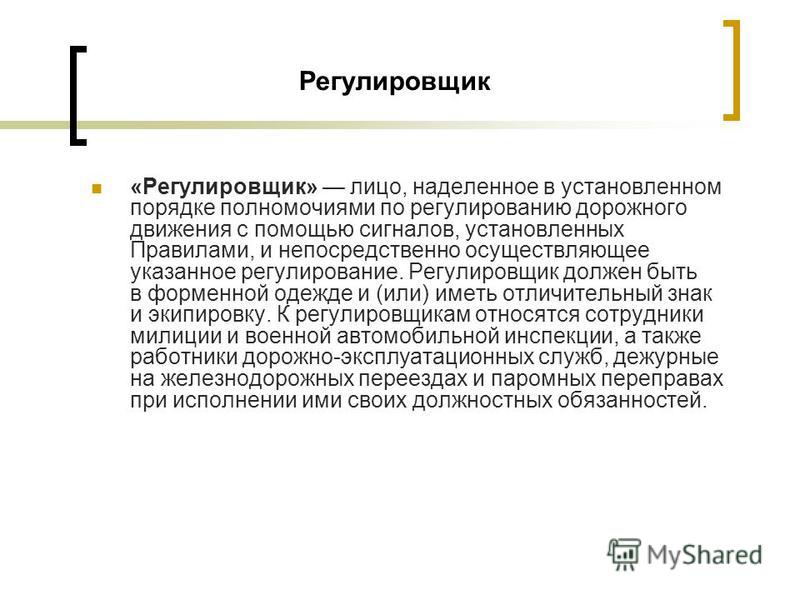



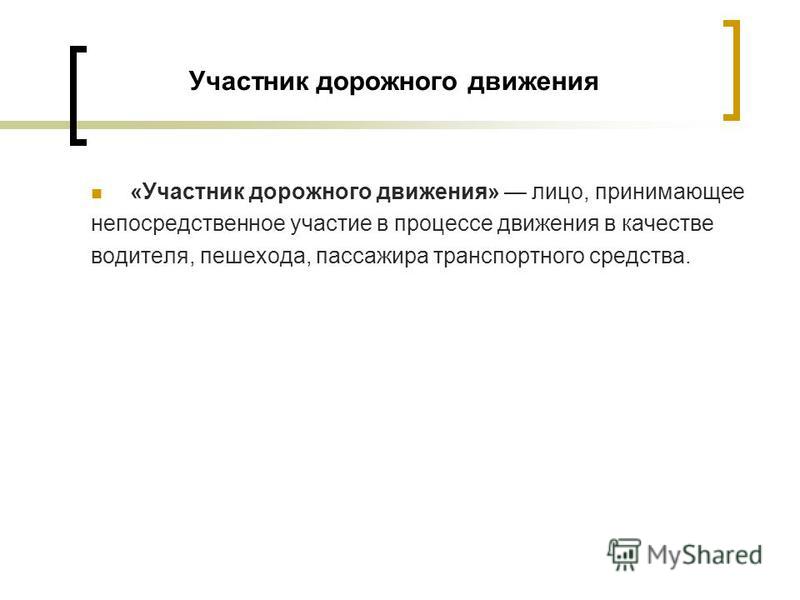

"Daytime running lights" "Daytime running lights" - external lighting devices designed to improve the visibility of a moving vehicle in front in bright light Times of Day"

"Limited visibility" "Limited visibility" - the driver's visibility of the road in the direction of travel, limited by the terrain, the geometric parameters of the road, vegetation, buildings, structures or other objects, including vehicles

Lead "Advance" - the movement of a vehicle at a speed greater than the speed of a passing vehicle

Obstacle "Obstacle" - a stationary object in the lane (faulty or damaged vehicle, defect in the roadway, foreign objects, etc.), which does not allow you to continue driving along this lane. A traffic jam or a vehicle stopped in this lane in accordance with the requirements of the Rules is not an obstacle
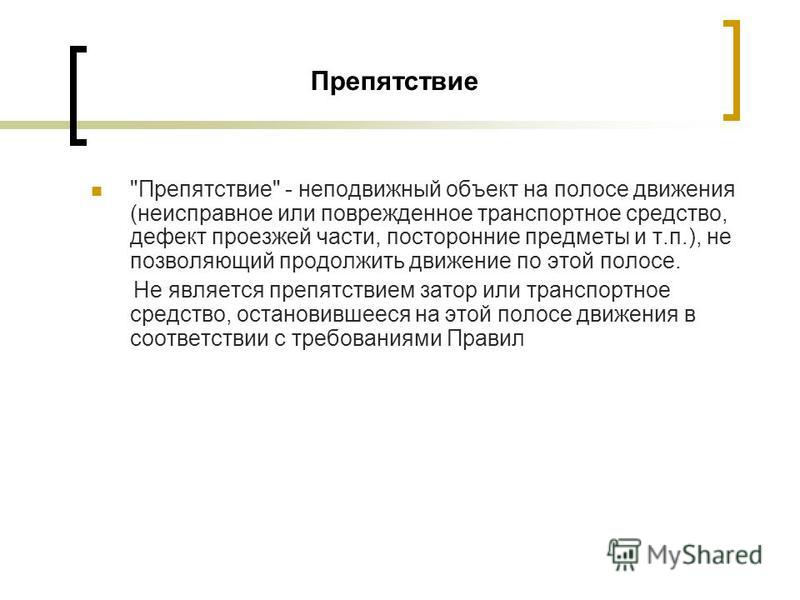
Dangerous goods Deletion of the word "natural" in the definition of "Dangerous goods"
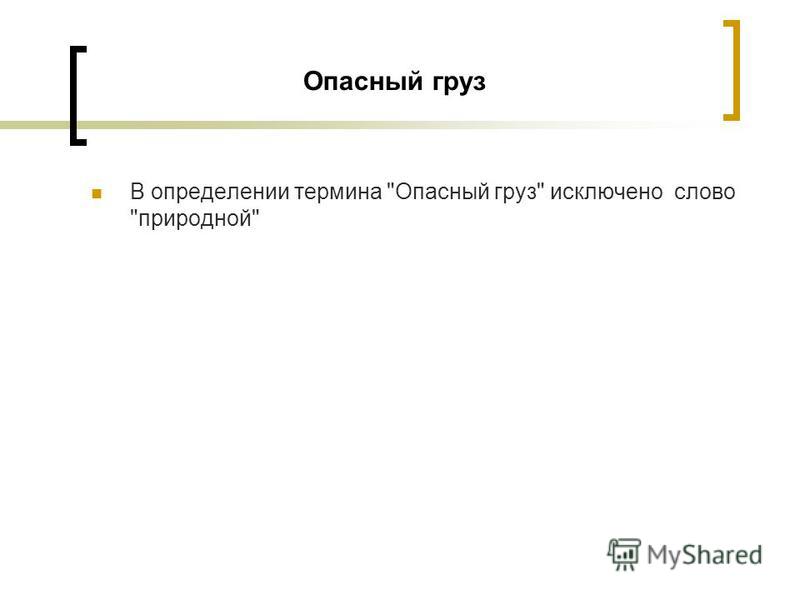
Checking the level of perception of the acquired knowledge 1. What are the main components that make it possible to define an event as a traffic accident? 2. What is included in the term "road"? 3. Can an Indian rickshaw be classified as a driver? 4. What category of road users does a shepherd belong to?

Solving a crossword puzzle 1. A road marked with a sign A place of intersection, junction or branching of roads on the same level 3. An element of the road intended for pedestrian traffic and adjacent to the carriageway or separated from it by a lawn. 4. A person duly empowered to regulate traffic with the help of signals established by the Rules, and directly exercising the said regulation. 5. Intentional stoppage of the movement of the vehicle for up to 5 minutes, as well as for more, if it is necessary for boarding or disembarking passengers or loading or unloading the vehicle.

Solving a crossword puzzle 6 A person driving a vehicle or a drover leading pack, riding animals or a herd along the road. 7. A vehicle not equipped with an engine and intended to be driven in combination with a power-driven vehicle. 8. Part of the road element intended for the movement of trackless vehicles 9. A person who is in (on) a vehicle, as well as a person who enters (gets on) a vehicle or exits a vehicle (disembarks from it).

Solve crossword 10. Two-wheeled motor vehicle with or without a side trailer. 11. Departure from the occupied lane or occupied lane while maintaining the original direction of movement. 12. Deliberate stoppage of the movement of the vehicle for more than 5 minutes for reasons not related to boarding or disembarking passengers or loading or unloading the vehicle. 13. Power-driven vehicle coupled to a trailer(s).
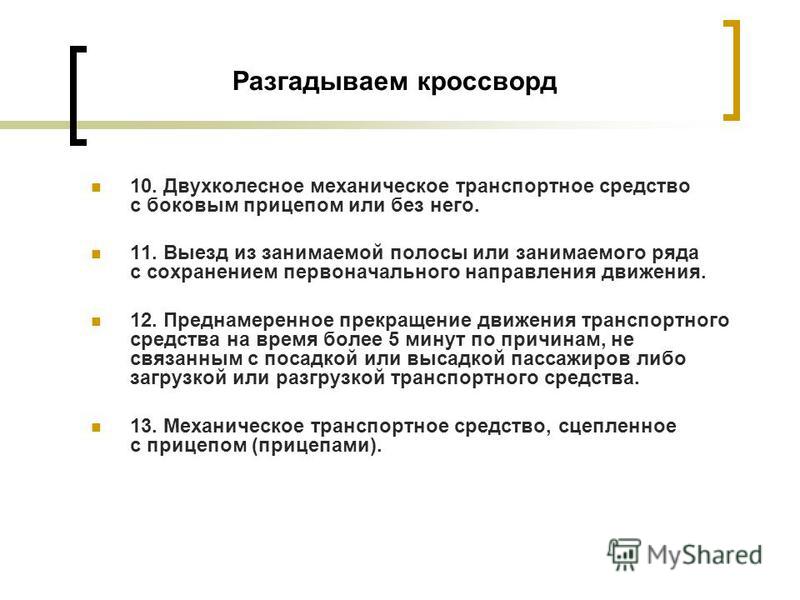
Solving a crossword puzzle 14. An element of the road adjacent directly to the carriageway at the same level with it, differing in the type of coverage or marked out using markings, used for driving, stopping and parking in accordance with the Rules. 15. Equipped or adapted and used for the movement of vehicles, a strip of land or the surface of an artificial structure. 16. Leading one or more moving vehicles associated with the departure from the occupied lane. 17. The right to priority movement in the intended direction in relation to other road users. 18. Vehicle, but not disabled carriage, having two wheels or more and set in motion by the muscular power of the people on it. Homework: outline and memorize the terms “Forced stop”, “Road traffic”, “Railway crossing”, “Route vehicle”, “Moped”, “ Locality”, “Insufficient visibility”, “Danger to traffic”, “Dangerous goods”, “ Organized transportation groups of children”, “Organized foot column”, “Organized transport column”, “ Crosswalk”, “Lane”, “Adjacent territory”, “Permitted maximum weight”, “Dark time of the day”, “Give way (do not interfere)”.


SUBJECT PROGRAM
"FOUNDATIONS OF LEGISLATION IN THE SPHERE
TRAFFIC"
Introduction. Review of legislative acts
Law on Road Safety, Rules of the Road, Code of Administrative Offenses, Criminal Code, Civil Code, Law on Protection environment, Law on Compulsory Civil Liability Insurance (OSAGO).
SECTION 1. RULES OF THE ROAD
Topic 1. General provisions. Basic concepts and terms. Responsibilities of Drivers, Pedestrians and Passengers
The value of the Rules in ensuring order and traffic safety. General structure of the Rules. Basic concepts and terms contained in the Rules.
Responsibilities of road users The procedure for introducing traffic restrictions.
Documents that the driver of a mechanical vehicle must carry with him and pass on to police officers for verification.
The procedure for providing vehicles to officials.
Rights and obligations of drivers of vehicles moving with a flashing blue light and a special sound signal. Responsibilities of other drivers to ensure the safety of the movement of special vehicles.
Responsibilities of drivers involved in a traffic accident. Obligations of pedestrians and passengers to ensure road safety.
Topic 2. Road signs
The meaning of road signs in the overall system of traffic management. Classification of road signs. Signage requirements. Duplicate, repeated and temporary signs.
Warning signs. Appointment. General warning sign. Rules for the installation of warning signs. The name and purpose of each sign. The actions of the driver when approaching a dangerous section of the road, marked with the corresponding warning sign.
Priority signs. Appointment. The name and location of each sign. Actions of drivers in accordance with the requirements of priority signs.
Prohibition signs. Appointment. General sign of prohibition. Name, purpose and location of each sign. Actions of drivers in accordance with the requirements of prohibition signs. Exceptions. Rights of drivers with disabilities and drivers carrying such persons. Area of prohibition signs.
Prescriptive signs. Appointment. General indication of prescription. Name, purpose and location of each sign. The actions of drivers in accordance with the requirements of prescriptive signs. Exceptions.
Signs of special orders. Appointment, common features. Name, purpose and location of each sign.
Information signs. Appointment. General signs of signs. Name, purpose and location of each sign. The actions of drivers in accordance with the requirements of signs that introduce certain modes of movement.
Service signs. Appointment. Name and installation location.
Signs of additional information (plates). Appointment. Name and placement of each sign.
Topic 3. road markings and its characteristics
Significance of markings in the general organization of traffic, classification of markings.
Horizontal marking. Appointment. Color and conditions for applying each type of horizontal marking. Actions of drivers in accordance with the requirements of horizontal markings.
Vertical layout. Appointment. Color and conditions for applying each type of vertical marking.
Practical lesson on topics 1-3
Solution of complex problems. Analysis of typical traffic situations using technical training aids, models, stands, etc. Formation of skills to be guided by road signs and markings.
Topic 4. Traffic order, stopping and parking of vehicles
Warning signals. Types and purpose of signals. Rules for signaling by light direction indicators and hand. Use of warning signals when overtaking. Dangerous consequences of non-compliance with the rules for issuing warning signals.
Start of movement, maneuvering. Duties of drivers before starting to move, changing lanes and maneuvering. How to make a turn at an intersection. Turn left and turn outside the intersection. Actions of the driver in the presence of an acceleration (deceleration) lane. Places where U-turn is prohibited.
Reverse order. Places where reversing is prohibited.
Dangerous consequences of non-observance of the rules of maneuvering.
Location of vehicles on the road. Requirements for the location of vehicles on the carriageway, depending on the number of lanes for traffic, types of vehicles, speed of movement.
Cases when traffic is allowed on tram tracks. Turns on the road with reverse movement.
Dangerous consequences of non-compliance with the rules for the location of vehicles on the roadway.
Movement speed. Factors affecting the choice of speed. Speed limits in urban areas. Speed limits outside built-up areas, on motorways for various categories Vehicle. Prohibitions when choosing a speed mode. Choice of distance and intervals. Special requirements for drivers of slow and heavy vehicles.
Dangerous consequences of non-observance of safe speed and distance.
Overtaking and oncoming traffic. Obligations of the driver before overtaking. Actions of drivers when overtaking. Places where overtaking is prohibited.
Oncoming traffic on narrow sections of roads. Oncoming driving on ups and downs. Dangerous consequences of non-observance of the rules of overtaking and oncoming passing.
Stop and parking. Stopping and parking order. How to park vehicles. Long-term parking outside settlements. Precautions when parking a vehicle. Places where stopping and parking are prohibited.
Dangerous consequences of non-compliance with the rules of stopping and parking.
Topic 5. Traffic regulation
Means of traffic control. The meanings of traffic lights and the actions of drivers in accordance with these signals. Reversible traffic lights. Traffic lights to regulate the movement of trams, as well as other route vehicles moving along the lane allocated for them.
Significance of traffic controller signals for trams, pedestrians and trackless vehicles. The procedure for stopping at traffic lights or a traffic controller that prohibits movement.
The actions of drivers and pedestrians in cases where the instructions of the traffic controller contradict traffic signals, road signs and markup.
Practical session on topics 4-5
Solving complex problems, analyzing typical traffic situations using technical training aids, mock-ups, stands, etc.
Develop hand warning skills. Formation of skills to correctly be guided by regulation signals, navigate, assess the situation and predict its development.
Topic 6
General rules for crossing intersections. Cases where tram drivers have advantages.
Adjustable crossroads. Interaction of traffic signals and priority signs. The order and sequence of movement at a regulated intersection.
Unregulated intersections. The order of movement at the intersections of equivalent roads. The order of movement at the intersections of unequal roads.
The sequence of crossing the intersection when the main road changes direction.
The actions of the driver in case he cannot determine the presence of coverage on the road (dark hours, mud, snow, etc.) and in the absence of priority signs.
Topic 7 funds and railway crossings
Pedestrian crossings and stops of route vehicles. Responsibilities of a driver approaching an unregulated pedestrian crossing, a stop of route vehicles or a vehicle bearing the "Children's Carriage" identification mark.
Railway crossings. Types of railroad crossings. The device and features of the operation of modern railway signaling at crossings. The order of movement of vehicles.
Rules for stopping vehicles before moving. Responsibilities of the driver in the event of a forced stop at the crossing.
Prohibitions in force at the railway crossing.
Cases requiring coordination of traffic conditions through the crossing with the head of the distance of the railway track.
Dangerous consequences of violation of the rules for the passage of pedestrian crossings, stops of route vehicles and railway crossings.
Practical session on topics 6-7
Solution of complex problems. Analysis of typical traffic situations using technical training aids, models, stands, etc.
Topic 8. Special traffic conditions
Highway traffic. Prohibitions on highways. Obligations of drivers in case of forced stop on the carriageway of the motorway and on the side of the road.
Movement in residential areas.
Shuttle vehicle priority. Tramway crossing outside the intersection.
The order of movement on the road with a dedicated lane for route vehicles. Rules for the behavior of drivers in cases where a trolleybus or bus starts moving from a designated stop.
Rules for the use of external lighting devices and sound signals.
Turning on low beam headlights during daylight hours. Actions of the driver at blinding. The procedure for using fog lights, searchlights, searchlights and rear fog lights, a road train sign.
Cases allowing the use of sound signals.
Towing of mechanical vehicles. Conditions and procedure for towing motor vehicles on a flexible hitch, a rigid hitch and a partial loading method.
Cases where towing is prohibited.
Transportation of people in towed and towed vehicles. Dangerous consequences of non-compliance with the rules for towing motor vehicles.
Training ride. Conditions under which practice driving is permitted. Requirements for a training, trainable and training motor vehicle.
Requirements for the movement of cyclists, mopeds, horse-drawn carts, as well as the passage of animals (prohibitions and age limit from which driving is allowed).
Topic 9. Transportation of people and goods
Requirement for the transportation of people in a truck. Responsibilities of the driver before the start of the movement. The speed of movement when transporting people. Additional requirements for the transportation of children. Cases where the transportation of people is prohibited.
Rules for placing and securing cargo on a vehicle. Transportation of goods that exceed the dimensions of the vehicle.
Designation of the transported cargo. Cases requiring coordination of the conditions for the movement of vehicles with the traffic police.
Dangerous consequences of non-compliance with the rules for the transport of people and goods.
Topic 10. Technical condition and equipment of vehicles
General requirements. Conditions under which the operation of vehicles is prohibited.
Malfunctions in the event of which the driver must take measures to eliminate them, and if this is not possible, proceed to the place of parking or repair, observing the necessary precautions.
Malfunctions in which further movement is prohibited.
Dangerous consequences of operating a vehicle with malfunctions that threaten road safety.
Topic 11. State registration marks, identification marks, warning labels and designations
Requirements for the equipment of vehicles with state registration marks and designations.
CHAPTER2. REGULATORYDOCUMENTATION,
REGULATORY RELATIONS IN THE SPHERE OF ROAD TRAFFIC
Topic 12. Administrative law
Administrative offense (APN) and administrative responsibility.
Administrative penalties: warning, administrative fine, deprivation of a special right, administrative arrest and confiscation of the instrument or subject of the APN. Bodies imposing administrative penalties, the procedure for their execution. Measures taken by authorized persons in order to ensure the proceedings on the APN case (withdrawal of a driver's license, detention of a vehicle, etc.).
Topic 13. Criminal law
The concept of criminal responsibility. Corpus delicti. Types of punishments.
Crimes against traffic safety and transport operation. Crimes against life and health (leaving in danger) Conditions for criminal liability.
Topic 14. Civil law
The concept of civil liability. Grounds for civil liability. Concepts: harm, guilt, illegal action. Liability for damage caused in an accident. Compensation for material damage.
The concept of liability for damage caused. Conditions and types of liability, limited and full liability.
The right of ownership, subjects of the right of ownership. Ownership and possession of a vehicle.
Vehicle owner tax.
Topic 15. Legal framework for environmental protection
The concept and meaning of nature conservation. Legislation on the protection of nature. Purposes, forms and methods of nature conservation.
Objects of nature subject to legal protection: land, subsoil, water, flora, atmospheric air, reserved natural objects.
The system of bodies regulating relations for the legal protection of nature, their competences, rights and obligations.
Responsibility for violation of legislation on nature protection.
Topic 16
Federal Law "On Compulsory Civil Liability Insurance". Insurance procedure. The procedure for concluding an insurance contract. Insurance case. Grounds and procedure for payment of the sum insured.
Practical session on topic 16
Fill out an accident report form.
DocumentThe exam is held according to academic subjects corresponding Model programs: « Basics legislation in sphere road movements»; "Device and Maintenance transport...
The explanatory note of the educational program for the professional training of drivers of vehicles of category "B" (hereinafter referred to as the program) was developed in accordance with the requirements of the Federal Law of December 10, 1995 n 196-fz "On Road Safety" (Collection of Legislation of the Russian Federation,
Explanatory noteD. Explanatory note Working program subject "Basics legislation in sphere road movements"aimed at the formation theoretical foundations legislation in sphere road movements and using the received...
Educational program for the training of drivers of vehicles of category "B" 1 educational program of the subject "
Educational program... PROGRAM SUBJECT "BASICS LEGISLATION AT SPHERE ROAD MOVEMENTS" Introduction. Review of legislative acts. SECTION 1. RULES ROAD MOVEMENTS... liquids. 3 EDUCATIONAL PROGRAM SUBJECT "BASICS SAFE TRANSPORT MANAGEMENT...





